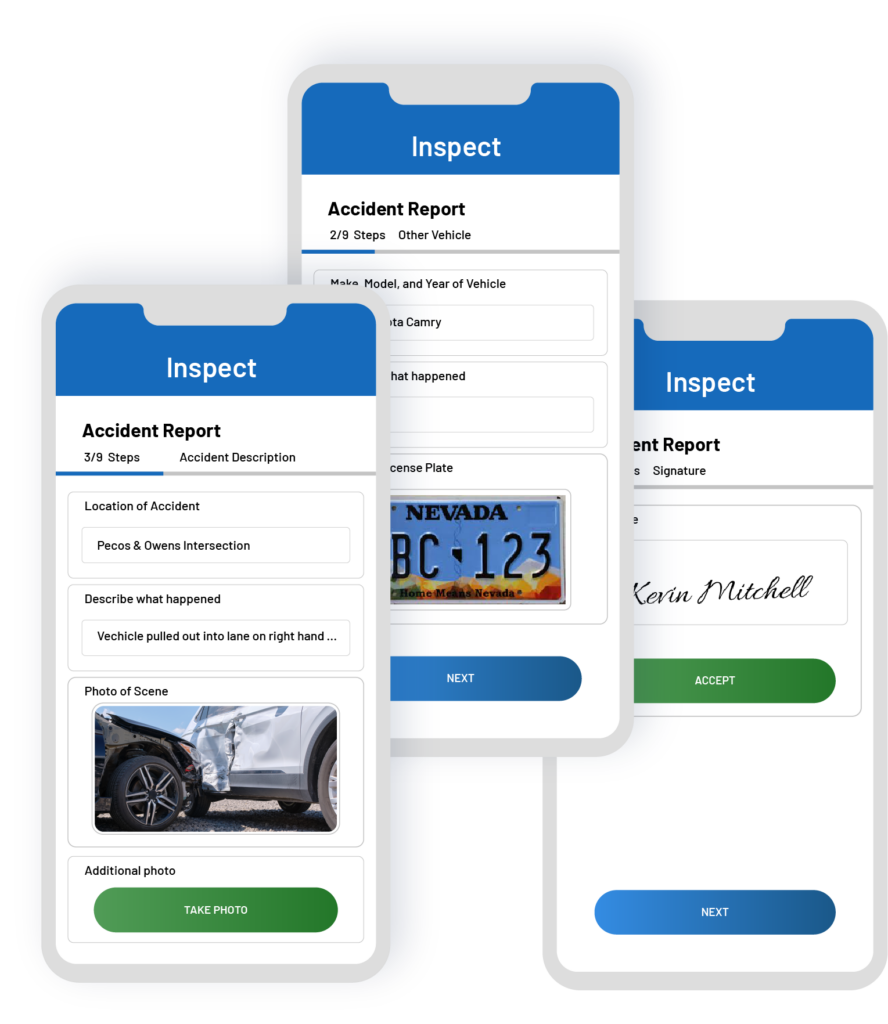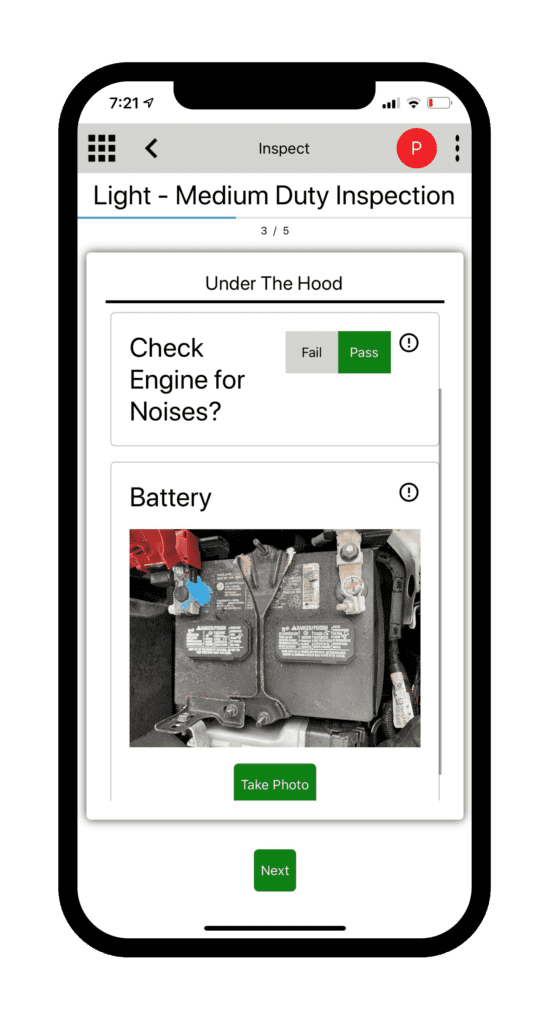Staying safe on the road means keeping up FMCSA regulations such as pre and post-trip inspections. From assessing your vehicle to reporting damage and defects, there’s a lot of fleet safety measures to stay on top of to be compliant.
We’ve put together a comprehensive guide on what exactly a DVIR is, important regulations and exemptions, and a helpful checklist to follow for enhanced efficiency with the use of digital inspections.

What Is a DVIR?
DVIR stands for driver vehicle inspection report. A DVIR is a formal record that confirms a driver has completed a commercial motor vehicle (CMV) inspection. FMCSA regulates vehicle inspections including pre and post-trip checks.
- A pre-trip inspection is an examination of all major components to ensure the vehicle is safe to begin a trip.
- A post-trip inspection is an examination of all vehicle components to identify vehicle defects after a trip.
The purpose of a DVIR, other than stay DOT compliant, is to identify potential safety issues and vehicle defects before they lead to incidents. This not only saves you from costly fines, but it can also extend the life of your vehicles and protect your most important asset: drivers.
What Is an eDVIR?
Drivers traditionally rely on paper and pencil to manually complete DVIRs. But much of the process has since gone digital. Many fleets are now arming drivers with electronic driver vehicle inspection apps (also known as an eDVIR). With an eDVIR, managers can create custom vehicle inspection checklists and workflows and deploy them to a driver’s mobile device. These apps also allow drivers to take photographs of vehicle issues and upload them immediately for review.
Not only do eDVIRs make reporting vehicle defects easier than ever, but they also allow you to monitor DVIR compliance in real-time and gain full visibility of inspection trends across your fleet.
Read the 10 benefits of paperless fleet inspections
Who Needs to Complete a DVIR?
DVIR regulations apply to most commercial vehicle drivers. A commercial vehicle:
- Has a gross vehicle weight rating or combination weight rating of 4,537 kg (10,001 lb) or more, whichever is greater.
- Transports between 9 and 15 passengers (including the driver) for compensation.
- Is used to transport 16 or more passengers.
- Is designed to transport hazardous materials per the Hazardous Materials Transportation Act.
If you are a commercial driver, you are required to complete a DVIR that identifies the vehicle and lists any defect(s) discovered that would affect the safety of operation of the vehicle. If you do not discover a defect or deficiency, the vehicle has passed the inspection.

DVIR Regulations
There are a number of FMCSA DVIR requirements. These include specifics on how to properly report vehicle defects and damage, such as:
- Every motor carrier shall require its drivers to report, and every driver shall prepare a report in writing at the end of the day on each vehicle operated, except for intermodal equipment tendered by an intermodal equipment provider. At minimum, the report must include the following parts outlined in the DVIR inspection checklist.
- Every motor carrier and intermodal equipment provider must systematically inspect, repair, and maintain all motor vehicles and intermodal equipment subject to its control.
- Before requiring or permitting a driver to operate a vehicle, every motor carrier shall repair any defect listed on the DVIR which would be likely to affect the safety of operation of the vehicle.
These regulations ensure that both motor carriers and drivers understand the DVIR process and how to follow protocols to avoid fines.
DVIR Exemptions
DVIR regulations do not apply to everyone. Those that apply to the following are exempt from FMCSA’s DVIR protocols:
- Private passenger motor carriers.
- Driveaway-towaway operations.
- Any motor carrier operating a single commercial motor vehicle.
If any of the above apply to you, you are exempt from following DVIR protocols, though examining your vehicle is still a good idea. This will ensure the longevity of your vehicle(s).
The DVIR Inspection Process
The DVIR process includes four key steps that drivers must follow, including inspecting, identifying, submitting, and taking action in the event of a vehicle defect.
While you can complete inspections manually or digitally, filling out paper inspections can be a burden—not to mention time-consuming. Digital inspections can save you time, leading to more effective operations especially when paired with an electronic logging device (ELD).
While regulations specify what needs to be in a DVIR, it doesn’t explain how to fill out a DVIR form given that they can be manual or digital. However you perform your inspections, follow these four steps to complete the DVIR process.
1. Inspect Vehicle
Inspect the vehicle by doing a walk-around examination. Check lights, tires, mirrors, and additional parts outlined in the below inspection checklist.
2. Identify Defects
Identify and document vehicle damage or defects. This could include visible external defects such as mirror damage or vehicle maintenance issues under the hood.
3. Submit Report
Once you’ve inspected your vehicle, sign off and submit your report to the motor carrier. If filling out a paper report, this may have to happen after the workday. Download a paper form here.
4. Take Action
In the event of vehicle damage or defects, the motor carrier must take corrective action to repair the vehicle for safe operation. Once corrected, the carrier must certify that the vehicle has been repaired and can operate.
DVIR Inspection Checklist

To ensure you follow compliance regulations, we put together a helpful DVIR checklist. Be sure to assess each of the below FMCSA requirements, as well as additional vehicle components that are important to your operations.
Fleets subject to CFR 396.11 must include, at minimum, a vehicle assessment of:
- Service brakes including trailer brake connections
- Parking brake
- Steering mechanism
- Lighting devices and reflectors
- Tires
- Horn
- Windshield wipers
- Rearview mirrors
- Coupling devices
- Wheels and rims
- Emergency equipment
The driver must sign the report once the examination is complete. On two-driver operations, only one driver needs to sign the driver vehicle inspection report, provided both drivers agree as to the defects or deficiencies identified.
[Download a complete DVIR form here]
DVIR Penalties and Fines
Those who knowingly falsify or fail to complete a DVIR are subject to penalties outlined by the FMCSA. DVIR penalties and fines include:
- A maximum civil penalty of $1,270 a day for failing to complete a DVIR.
- A maximum civil penalty of $12,695 for knowingly falsifying, destroying, or changing DVIR records.
- A civil penalty not exceeding $15,419 for each non-recordkeeping violation.
In addition to the above fines, ignoring DVIR regulations come with additional penalties like vehicle decommission. This can impact overall fleet productivity and uptime. This is why it’s so important to follow DVIR regulations closely. Electronic DVIR solutions can help you stay on top of FMCSA regulations, making it easy to avoid fines and penalties.
How eDVIRs Can Improve Operations

When it comes to maintaining vehicle inspections, there are a lot of pieces to stay on top of. From creating a process that allows drivers to easily report issues to keeping up with vehicle maintenance and paperwork, digital inspections can help organize and store data.
IntelliShift’s eDVIR application provides users with the ability to customize DVIR forms and workflows. Because of this, processes are optimal for your entire workforce, not “one size fits all”. eDVIR’s reduce the time it takes your drivers to inspect vehicles, and make it easier for you to address issues quickly.
Using digital inspection software can help improve operations in many forms, mainly in the following ways:
1. Improves Data Accuracy
With eDVIRs, you can require proof of inspection and receive results in real-time. This helps you ensure the forms are complete and accurate. And because form submissions are sent digitally, data is stored automatically in one organized database rather than having to manually read through reports and file paperwork.
Plus, with eDVIRs you have the ability to design your forms and control inputs, ensuring data is consistent across all operations.
2. Saves Time and Money
Going paperless saves you both time and money when it comes to inspections. Manual paperwork takes more time to fill out and report, and paper logs are expensive. It is also inefficient when it comes to storing, organizing, and reporting data.
See how Liberty Coca-Cola saves 2,600 hours per facility per year by removing paper.
Paperless inspections are quick and easy to fill out, saving you time when interpreting results and initiating maintenance requests. Because you can retrieve reports quickly, users save countless hours when it comes to annual compliance reporting and DOT audits.
3. Increases Productivity
eDVIRs streamline efficiency across the board—from identifying failed inspections faster with more accurate results to scheduling maintenance needs before they become a problem.
By speeding these operations up, you increase asset lifespan and reduce downtime. This also allows streamlined communication between drivers and motor carriers, preventing data from falling through the cracks.
Connect operations and maintenance with digital inspections


